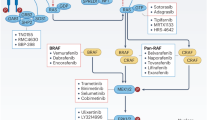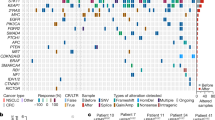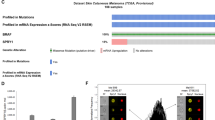Abstract
Identifying the spectrum of genetic alterations that cooperate with critical oncogenes to promote transformation provides a foundation for understanding the diversity of clinical phenotypes observed in human cancers. Here, we performed integrated analyses to identify genomic alterations that co-occur with oncogenic BRAF in melanoma and abrogate cellular dependence upon this oncogene. We identified concurrent mutational inactivation of the PTEN and RB1 tumor suppressors as a mechanism for loss of BRAF/MEK dependence in melanomas harboring V600EBRAF mutations. RB1 alterations were mutually exclusive with loss of p16INK4A, suggesting that whereas p16INK4A and RB1 may have overlapping roles in preventing tumor formation, tumors with loss of RB1 exhibit diminished dependence upon BRAF signaling for cell proliferation. These findings provide a genetic basis for the heterogeneity of clinical outcomes in patients treated with targeted inhibitors of the mitogen-activated protein kinase pathway. Our results also suggest a need for comprehensive screening for RB1 and PTEN inactivation in patients treated with RAF and MEK-selective inhibitors to determine whether these alterations are associated with diminished clinical benefit in patients whose cancers harbor mutant BRAF.
This is a preview of subscription content, access via your institution
Access options
Subscribe to this journal
Receive 50 print issues and online access
$259.00 per year
only $5.18 per issue
Buy this article
- Purchase on Springer Link
- Instant access to full article PDF
Prices may be subject to local taxes which are calculated during checkout







Similar content being viewed by others
References
Adjei AA, Cohen RB, Franklin W, Morris C, Wilson D, Molina JR et al. (2008). Phase I pharmacokinetic and pharmacodynamic study of the oral, small-molecule mitogen-activated protein kinase kinase 1/2 inhibitor AZD6244 (ARRY-142886) in patients with advanced cancers. J Clin Oncol 26: 2139–2146.
Bollag G, Hirth P, Tsai J, Zhang J, Ibrahim PN, Cho H et al. (2010). Clinical efficacy of a RAF inhibitor needs broad target blockade in BRAF-mutant melanoma. Nature 467: 596–599.
Chellappan S, Kraus VB, Kroger B, Munger K, Howley PM, Phelps WC et al. (1992). Adenovirus E1A, simian virus 40 tumor antigen, and human papillomavirus E7 protein share the capacity to disrupt the interaction between transcription factor E2F and the retinoblastoma gene product. Proc Natl Acad Sci USA 89: 4549–4553.
Chicas A, Wang X, Zhang C, McCurrach M, Zhao Z, Mert O et al. (2010). Dissecting the unique role of the retinoblastoma tumor suppressor during cellular senescence. Cancer Cell 17: 376–387.
Dankort D, Curley DP, Cartlidge RA, Nelson B, Karnezis AN, Damsky Jr WE et al. (2009). Braf(V600E) cooperates with Pten loss to induce metastatic melanoma. Nat Genet 41: 544–552.
Dankort D, Filenova E, Collado M, Serrano M, Jones K, McMahon M . (2007). A new mouse model to explore the initiation, progression, and therapy of BRAFV600E-induced lung tumors. Genes Dev 21: 379–384.
Davies H, Bignell GR, Cox C, Stephens P, Edkins S, Clegg S et al. (2002). Mutations of the BRAF gene in human cancer. Nature 417: 949–954.
Demers GW, Espling E, Harry JB, Etscheid BG, Galloway DA . (1996). Abrogation of growth arrest signals by human papillomavirus type 16 E7 is mediated by sequences required for transformation. J Virol 70: 6862–6869.
Draper GJ, Sanders BM, Kingston JE . (1986). Second primary neoplasms in patients with retinoblastoma. Br J Cancer 53: 661–671.
Dummer R, Robert C, Chapman P, Sosman J, Middleton M, Bastholt K et al. (2008). AZD6244 (ARRY-142886) vs temozolomide (TMZ) in patients (pts) with advanced melanoma: an open-label, randomized, multicenter, phase II study. J Clin Oncol 2 (20 May Suppl): abstr. 9033.
Dyson N, Howley PM, Munger K, Harlow E . (1989). The human papilloma virus-16 E7 oncoprotein is able to bind to the retinoblastoma gene product. Science 243: 934–937.
Eng C, Li FP, Abramson DH, Ellsworth RM, Wong FL, Goldman MB et al. (1993). Mortality from second tumors among long-term survivors of retinoblastoma. J Natl Cancer Inst 85: 1121–1128.
Flaherty KT, Puzanov I, Kim KB, Ribas A, McArthur GA, Sosman JA et al. (2010). Inhibition of mutated, activated BRAF in metastatic melanoma. N Engl J Med 363: 809–819.
Gonzalgo ML, Bender CM, You EH, Glendening JM, Flores JF, Walker GJ et al. (1997). Low frequency of p16/CDKN2A methylation in sporadic melanoma: comparative approaches for methylation analysis of primary tumors. Cancer Res 57: 5336–5347.
Gopal YN, Deng W, Woodman SE, Komurov K, Ram P, Smith PD et al. (2010). Basal and treatment-induced activation of AKT mediates resistance to cell death by AZD6244 (ARRY-142886) in Braf-mutant human cutaneous melanoma cells. Cancer Res 70: 8736–8747.
Hatzivassiliou G, Song K, Yen I, Brandhuber BJ, Anderson DJ, Alvarado R et al. (2010). RAF inhibitors prime wild-type RAF to activate the MAPK pathway and enhance growth. Nature 464: 431–435.
Heidorn SJ, Milagre C, Whittaker S, Nourry A, Niculescu-Duvas I, Dhomen N et al. (2010). Kinase-dead BRAF and oncogenic RAS cooperate to drive tumor progression through CRAF. Cell 140: 209–221.
Hingorani SR, Jacobetz MA, Robertson GP, Herlyn M, Tuveson DA . (2003). Suppression of BRAF(V599E) in human melanoma abrogates transformation. Cancer Res 63: 5198–5202.
Janakiraman M, Vakiani E, Zeng Z, Pratilas CA, Taylor BS, Chitale D et al. (2010). Genomic and biological characterization of exon 4 KRAS mutations in human cancer. Cancer Res 70: 5901–5911.
Joseph EW, Pratilas CA, Poulikakos PI, Tadi M, Wang W, Taylor BS et al. (2010). The RAF inhibitor PLX4032 inhibits ERK signaling and tumor cell proliferation in a V600E BRAF-selective manner. Proc Natl Acad Sci USA 107: 14903–14908.
Knudsen ES, Knudsen KE . (2008). Tailoring to RB: tumour suppressor status and therapeutic response. Nat Rev Cancer 8: 714–724.
Kumar R, Sauroja I, Punnonen K, Jansen C, Hemminki K . (1998). Selective deletion of exon 1 beta of the p19ARF gene in metastatic melanoma cell lines. Genes Chromosomes Cancer 23: 273–277.
Michaloglou C, Vredeveld LC, Soengas MS, Denoyelle C, Kuilman T, van der Horst CM et al. (2005). BRAFE600-associated senescence-like cell cycle arrest of human naevi. Nature 436: 720–724.
Munger K, Werness BA, Dyson N, Phelps WC, Harlow E, Howley PM . (1989). Complex formation of human papillomavirus E7 proteins with the retinoblastoma tumor suppressor gene product. EMBO J 8: 4099–4105.
Nusse M, Beisker W, Hoffmann C, Tarnok A . (1990). Flow cytometric analysis of G1- and G2/M-phase subpopulations in mammalian cell nuclei using side scatter and DNA content measurements. Cytometry 11: 813–821.
Ohren JF, Chen H, Pavlovsky A, Whitehead C, Zhang E, Kuffa P et al. (2004). Structures of human MAP kinase kinase 1 (MEK1) and MEK2 describe novel noncompetitive kinase inhibition. Nat Struct Mol Biol 11: 1192–1197.
Ohta M, Nagai H, Shimizu M, Rasio D, Berd D, Mastrangelo M et al. (1994). Rarity of somatic and germline mutations of the cyclin-dependent kinase 4 inhibitor gene, CDK4I, in melanoma. Cancer Res 54: 5269–5272.
Patton EE, Widlund HR, Kutok JL, Kopani KR, Amatruda JF, Murphey RD et al. (2005). BRAF mutations are sufficient to promote nevi formation and cooperate with p53 in the genesis of melanoma. Curr Biol 15: 249–254.
Poulikakos PI, Zhang C, Bollag G, Shokat KM, Rosen N . (2010). RAF inhibitors transactivate RAF dimers and ERK signalling in cells with wild-type BRAF. Nature 464: 427–430.
Pratilas CA, Hanrahan AJ, Halilovic E, Persaud Y, Soh J, Chitale D et al. (2008). Genetic predictors of MEK dependence in non-small cell lung cancer. Cancer Res 68: 9375–9383.
Psyrri A, DeFilippis RA, Edwards AP, Yates KE, Manuelidis L, DiMaio D . (2004). Role of the retinoblastoma pathway in senescence triggered by repression of the human papillomavirus E7 protein in cervical carcinoma cells. Cancer Res 64: 3079–3086.
Sebolt-Leopold JS, English JM . (2006). Mechanisms of drug inhibition of signalling molecules. Nature 441: 457–462.
Sebolt-Leopold JS, Herrera R . (2004). Targeting the mitogen-activated protein kinase cascade to treat cancer. Nat Rev Cancer 4: 937–947.
Sherr CJ . (2006). Divorcing ARF and p53: an unsettled case. Nat Rev Cancer 6: 663–673.
Solit DB, Garraway LA, Pratilas CA, Sawai A, Getz G, Basso A et al. (2006). BRAF mutation predicts sensitivity to MEK inhibition. Nature 439: 358–362.
Sondergaard JN, Nazarian R, Wang Q, Guo D, Hsueh T, Mok S et al. (2010). Differential sensitivity of melanoma cell lines with BRAFV600E mutation to the specific Raf inhibitor PLX4032. J Transl Med 8: 39.
Taylor BS, Barretina J, Socci ND, Decarolis P, Ladanyi M, Meyerson M et al. (2008). Functional copy-number alterations in cancer. PLoS ONE 3: e3179.
The Cancer Genome Atlas Research Network (2008). Comprehensive genomic characterization defines human glioblastoma genes and core pathways. Nature 455: 1061–1068.
Thomas RK, Baker AC, Debiasi RM, Winckler W, Laframboise T, Lin WM et al. (2007). High-throughput oncogene mutation profiling in human cancer. Nat Genet 39: 347–351.
Tsai J, Lee JT, Wang W, Zhang J, Cho H, Mamo S et al. (2008). Discovery of a selective inhibitor of oncogenic B-Raf kinase with potent antimelanoma activity. Proc Natl Acad Sci USA 105: 3041–3046.
Tsai J, Zhang J, Bremer R, Artis R, Hirth P, Bollag G . (2006). Development of a novel inhibitor of cogenic b-raf. AACR Meeting Abstracts 2006: 571a.
Venkatraman ES, Olshen AB . (2007). A faster circular binary segmentation algorithm for the analysis of array CGH data. Bioinformatics 23: 657–663.
Wellbrock C, Ogilvie L, Hedley D, Karasarides M, Martin J, Niculescu-Duvaz D et al. (2004). V599EB-RAF is an oncogene in melanocytes. Cancer Res 64: 2338–2342.
Acknowledgements
We thank Drs Meenhard Herlyn and Kate Nathanson (University of Pennsylvania) and Dr Øystein Fodstad (Department of Tumor Biology of The Norwegian Radium Hospital, Norway) for kindly providing cell lines. This study was supported by grants from the National Institutes of Health (DBS), the Kimmel Foundation (DBS), Golfers-Against-Cancer (DBS), the Melanoma Research Alliance (DBS) and STARR Foundation (DBS). BST is the David H Koch Fellow in cancer genomics.
Author information
Authors and Affiliations
Corresponding author
Ethics declarations
Competing interests
David Solit has received honoraria and research funding from AstraZeneca, and had an advisory role with Roche. Gideon Bollag is an employee of Plexxikon Inc.
Additional information
Supplementary Information accompanies the paper on the Oncogene website
Rights and permissions
About this article
Cite this article
Xing, F., Persaud, Y., Pratilas, C. et al. Concurrent loss of the PTEN and RB1 tumor suppressors attenuates RAF dependence in melanomas harboring V600EBRAF. Oncogene 31, 446–457 (2012). https://doi.org/10.1038/onc.2011.250
Received:
Revised:
Accepted:
Published:
Issue Date:
DOI: https://doi.org/10.1038/onc.2011.250
Keywords
This article is cited by
-
BRAF — a tumour-agnostic drug target with lineage-specific dependencies
Nature Reviews Clinical Oncology (2024)
-
Control of cell state transitions
Nature (2022)
-
Clinical cancer genomic profiling
Nature Reviews Genetics (2021)
-
Inhibition of endothelin-B receptor signaling synergizes with MAPK pathway inhibitors in BRAF mutated melanoma
Oncogene (2021)
-
Integrin-Src-YAP1 signaling mediates the melanoma acquired resistance to MAPK and PI3K/mTOR dual targeted therapy
Molecular Biomedicine (2020)



